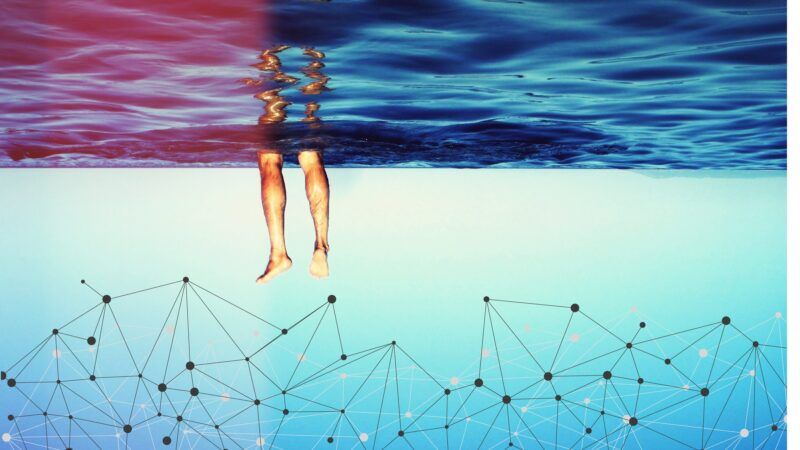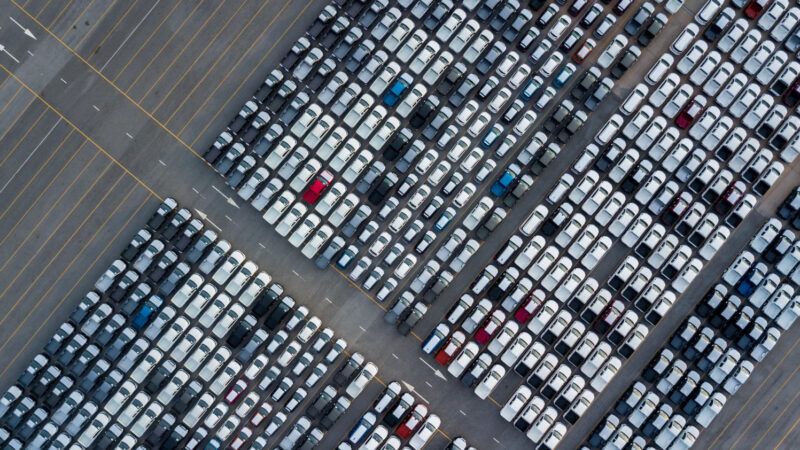 The technologies identified by the Port of Barcelona experts bring flexibility, security, resilience and transparency. (Image generated by artificial intelligence via Wombo.art).
The technologies identified by the Port of Barcelona experts bring flexibility, security, resilience and transparency. (Image generated by artificial intelligence via Wombo.art).
2022, the decisive year for the ports’ technological revolution
We asked the experts at the Port of Barcelona to identify the digital technologies essential for smart ports. These are the ten logistics trends they suggest for 2022. To illustrate these trends we have chosen images generated by Artificial Intelligence introducing concepts linked to port logistics as design elements (wombo.art).
 The technologies identified by the Port of Barcelona experts bring flexibility, security, resilience and transparency. (Image generated by artificial intelligence via Wombo.art).
The technologies identified by the Port of Barcelona experts bring flexibility, security, resilience and transparency. (Image generated by artificial intelligence via Wombo.art).
The digital technologies that will impact port logistics by 2022
The port of today is not the port of tomorrow. The implementation of a set of digital technologies detected as 'key' by experts from different departments of the Port of Barcelona will be a reality during this 2022. These are ten technological trends whose degree of implementation is expected to generate a remarkable effect, not only in port activity, but also in global logistics.
These technologies, most of them digital, are the result of an exchange between managers from various departments, the result of which is illustrated in the infographic below.
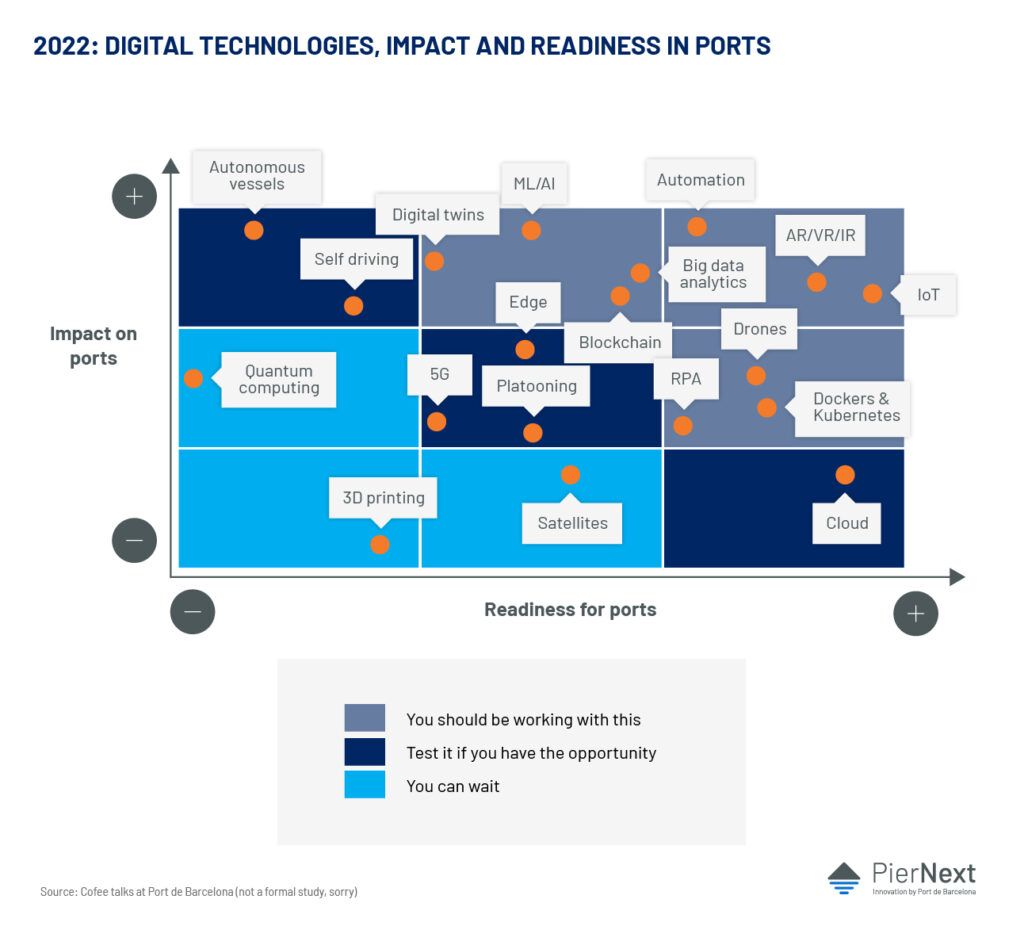
1. Machine Learning and Artificial Intelligence
Machine learning consists of "teaching" machines to learn by themselves so that their work is optimized and they know how to sift through what data is or is not useful.
Machine learning is often confused with AI, but it is only a part of it. It involves processes in which the machines themselves create their own rules (algorithms) and predictions based on data provided by humans.
Although its irruption occurred four or five years ago, the emergence of the Internet of Things (IoT), 5G and Edge Computing represent a substantial improvement in the collection, transport and transmission of data obtained from sensors, cameras and other information-gathering devices.
Operational processes such as container movement or traffic volume forecasting are examples of its implementation.
Deep learning is a subdomain or type of machine learning. It bases its power on what we know as neural networks, layers and layers of information processing. Unlike machine learning, the systems, with little supervision, are able to learn to improve themselves as they gain experience.
Many of the most recent innovations in artificial intelligence are linked to this form of learning and the advance of big data. But beware, because although all deep learning is machine learning, not all machine learning is deep learning.
"At the Port of Barcelona, machine learning is being used to improve the OCR reading of containers and trains, using TensorFlow. Artificial Intelligence algorithms are also used to predict waiting times to pick containers up at the terminals," explains Enric Rodellas, head of GIS at the Port of Barcelona.
2. Digital twin
A digital twin is a virtual representation of a physical system. In the case of ports, it allows for more operationally efficient decision making, data management and the avoidance of dangerous situations.
These simulation models are designed to solve hypothetical crises that may be high-risk without putting port personnel at risk. From burning cargo to toxic spills, the digital twin allows port personnel to monitor vessel movements, infrastructure, geographic information, assist pilots in their operations or reduce fuel consumption rates.
At the Port of Barcelona, the base or canvas of the digital twin is being built from the combination of existing data in the Geographic Information System, BIM technology and 3D models obtained by satellite imaging and LIDAR data from drones. The 1,400 Ha of the port contains 1 million elements (buildings, utility networks, traffic signals, hydrants, etc.) that have been designed and installed. And then transferred to their operation and maintenance.
"The digital twin of the port will add the characteristics of these elements to the 3D model, the maintenance operations performed, as well as real-time operation information. For example, which vehicles are transiting through an access gate. The digital twin will also be used for the planning and design of new infrastructures, as well as on the basis of the dashboards that are being defined," Rodellas points out.
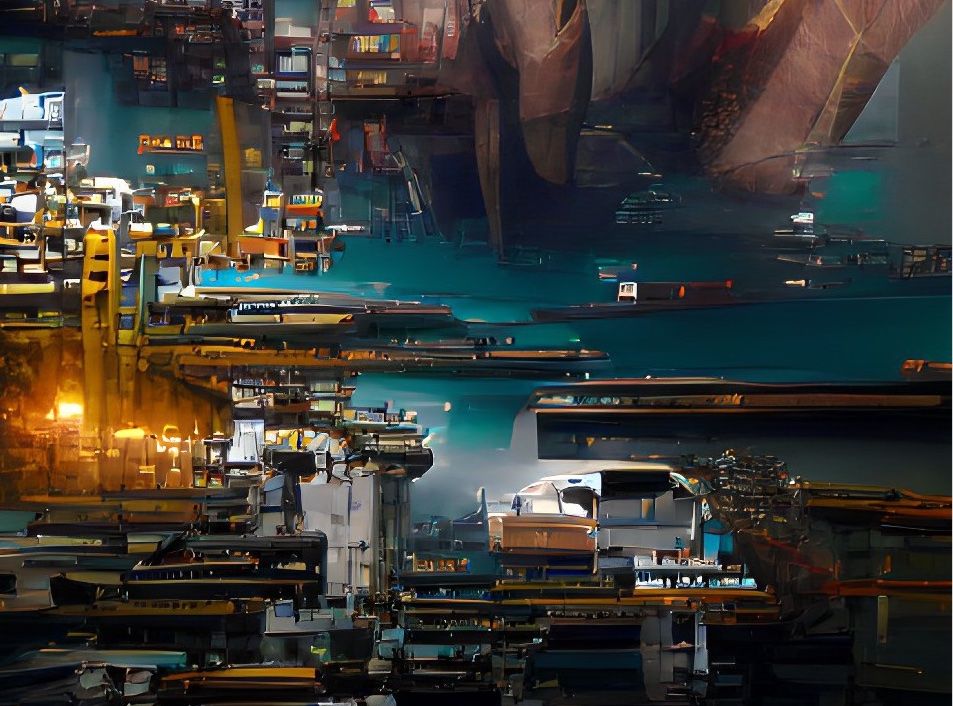
3. Automation
A rather broad concept that can be applied to vehicles, logistics processes or even port terminals. In the case of the former, thanks to artificial intelligence programs, automation allows vehicles to make their own decisions without the need for human interaction.
In the second scenario, automation adapts logistics processes to current needs with flexibility, resilience and transparency. Globalization and recent crises demand planning models capable of finding alternative materials and resources, new ways of securing supply and minimizing disruptions. This can be achieved through automation.
In the case of port terminals, automation can minimize errors by reducing human intervention, increase efficiency, reduce the operating cost of a terminal, increase security and, finally, reduce the carbon footprint.
"Automation in the port environment is a continuous process, which is advancing at an intense pace and still has room for improvement according to the different emerging technologies to be incorporated. Issues such as robotization, autonomous and connected vehicles, AI-based decision making or the automation of electronic documentation will bring great benefits in terms of safety, productivity and the environment," says David Serral, director of information systems at the Port.
4. Big Data Analysis
The management of large volumes of data is and will be key to a myriad of scenarios. They have an impact on maritime operations thanks to the collection, in real time, of millions of sensor data. This massive collection can be done, among others, with bathymetries or satellites with software that organizes, manages, analyzes, shares and distributes the information obtained for post-processing.
The usefulness of big data is wide and varied. It makes it possible to make predictive models that are used, for example, in the virtual gates through which thousands of vehicles enter every day.
"Storing huge amounts of data is something has become normal in any organization, the key now is how to efficiently manage and treat this information with two key objectives within our reach: to analyze the information in real time, allowing us to operate and manage efficiently, and to analyze future models of behavior by studying these variables, that is, to anticipate," says Serral.
5. Virtual/Augmented Reality
We have already talked about virtual twins and virtual gates, the best examples of the application of virtual reality in the port environment, and how they allow us to simulate and predict a multitude of scenarios. However, these digital technologies are also extremely useful in, for example, the training of specialized personnel.
Especially in those tasks in which the handling of, for example, heavy machinery, may pose some risk to operators. Or the management or maintenance of facilities as complex as port environments.
"Having digital models and being able to "navigate" them using virtual and augmented reality will have an impact on changes in facility management, maintenance and training models, so that many risky jobs can be prepared with higher success and less risk to employee’s safety. Additionally, the advantages of this technology in the field of training are already being successfully applied in training on the use of complex machinery present in our facilities," shares Serral.
6. Internet of Things
The Internet of Things or Internet of Things (IoT), are devices connected thanks to 5G that transmit and receive information. It is, in short, a network of digital interconnection between devices, people and the Internet itself that allows data exchange and capture key information about the use and performance of these devices.
These are connected and communicate with a process called "machine-to-machine" in which any two devices or machines communicate with each other without the need for human intervention. This communication is carried out with sensors placed in these devices and allows them to generate and obtain a large amount of data stored in an IoT platform that collects, processes and analyzes them.
"Sensorics has become enormously more flexible in recent years. We used to talk about spires that counted vehicles or smoke detectors. Today a video camera, a broad spectrum camera, multigas sniffers or a LIDAR device can provide much more information and are much more versatile, but the interpretation of the data requires subsequent analytics, in many cases based on artificial intelligence or machine learning," says Carles Rúa, head of innovation at the Port.
"Robotization, autonomous and connected vehicles, AI-based decision making or the automation of electronic documentation will bring great benefits in terms of Safety, Productivity and Environment."
- David Serral, director of information systems at the Port of Barcelona.
7. Drones
In the port area, drones or unmanned aerial vehicles improve safety, speed, effectiveness and response capacity. This is being demonstrated by several pilots carried out to test their usefulness in different scenarios and operations. Thanks to sensors, drones incorporate cameras that make it possible to obtain images or a cloud of millions of points of the terrain over which they fly to obtain essential information on the topographical characteristics of the area or to prevent and detect risk situations from the air.
Although to see them flying over the port facilities there are still some hurdles to overcome, basically legislative, everything seems to indicate that change is just around the corner and that they will eventually become an indispensable tool for the development of smart ports.
"At the Port, work using aerial drones is already being carried out on a regular basis to inspect the condition of the docks and piers. The objective is to detect movements in the infrastructure that announce risks on the docks and piers. In the future, when the Port has been declared an airspace for drones, their use will be extended to monitoring operations and surveillance in real time," Rodellas shares.
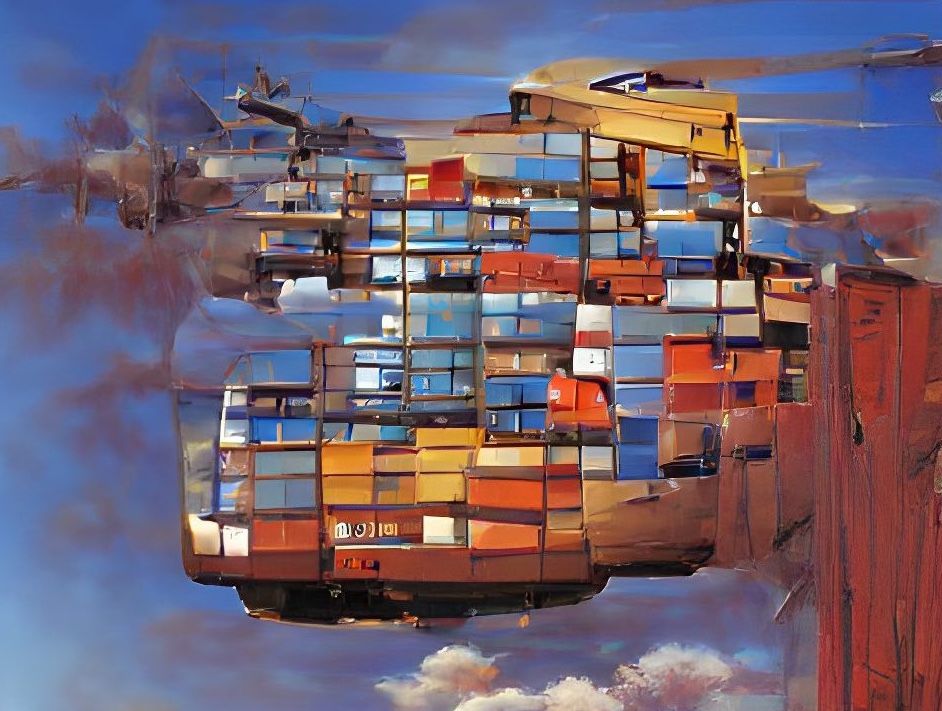
8. Robotic Process Automation
Robotic Process Automation (RPA) is the use of software robots (bots) to perform repetitive tasks previously performed by humans. RPA increases efficiency and is part of a business process management (BPM) strategy.
Its presence in port management is on the rise, as demonstrated by the second call of the Ports 4.0 fund, in which, of the 19 pre-commercial projects, three of them employ process automation.
"RPA is a technology that allows a simplified cost reduction as well as having 24/7 logistics in an environment where the efficiency of the logistics chain depends on the less efficient part of it," clarifies Catalina Grimalt, deputy general manager of organization and internal resources of the Port of Barcelona.
9. Dockers and Kubernetes
Docker is an open source technology and container file format that makes it possible to automate the deployment of applications running in the cloud. As applications grow to span multiple containers running on multiple servers, managing them becomes a more complex job.
Kubernetes is an open source orchestration software that provides an API to control how and where containers will run. It offers a solution to some of the complexities that arise when scaling multiple containers deployed on multiple servers.
Although they are different technologies, they work together to compile, deliver and scale containerized applications.
10. Blockchain integration
Blockchain enables companies to track and trace the journey of a product from when it leaves the factory until it reaches the end customer. The system records all relevant supply chain information in a database that executes smart contracts once certain conditions have been met. For example, delivery confirmation by the driver.
Together with IoT, blockchain will enable smarter logistics. It will transmit the status of the goods and verify whether they have been delivered according to the agreed requirements, bringing greater transparency and security to logistics operations. "The Port of Barcelona is participating in the project to track the sea and land journey of containers implemented by IBM and Maersk," Rodellas points out.
"As a technology applied to logistics and port management, blockchain has a great future. However, without wishing to generalize, most of the solutions I have seen based on blockchain actually tackled problems that, in the end, did not need this technology, while the problems where blockchain should be the great solution remain unsolved. I think this situation will change radically in the next two or three years," adds Rúa.
This article has been illustrated with images generated by Artificial Intelligence thanks to Wombo.art. This application developed by a Canadian startup, which only asks for a concept and a predefined artistic style to generate something totally new in just 20 seconds, is a sample of the growing number of applications that allow the generation of unique images using Generative adversarial networks (GAN).
These are algorithmic architectures that use two neural networks, pitted against each other to generate new synthetic instances of data that can pass for real data. The startup is already preparing an evolution of the application to be able to immediately create NFT's and put them on the market.
To learn more about trends in logistics and ports in 2022:




